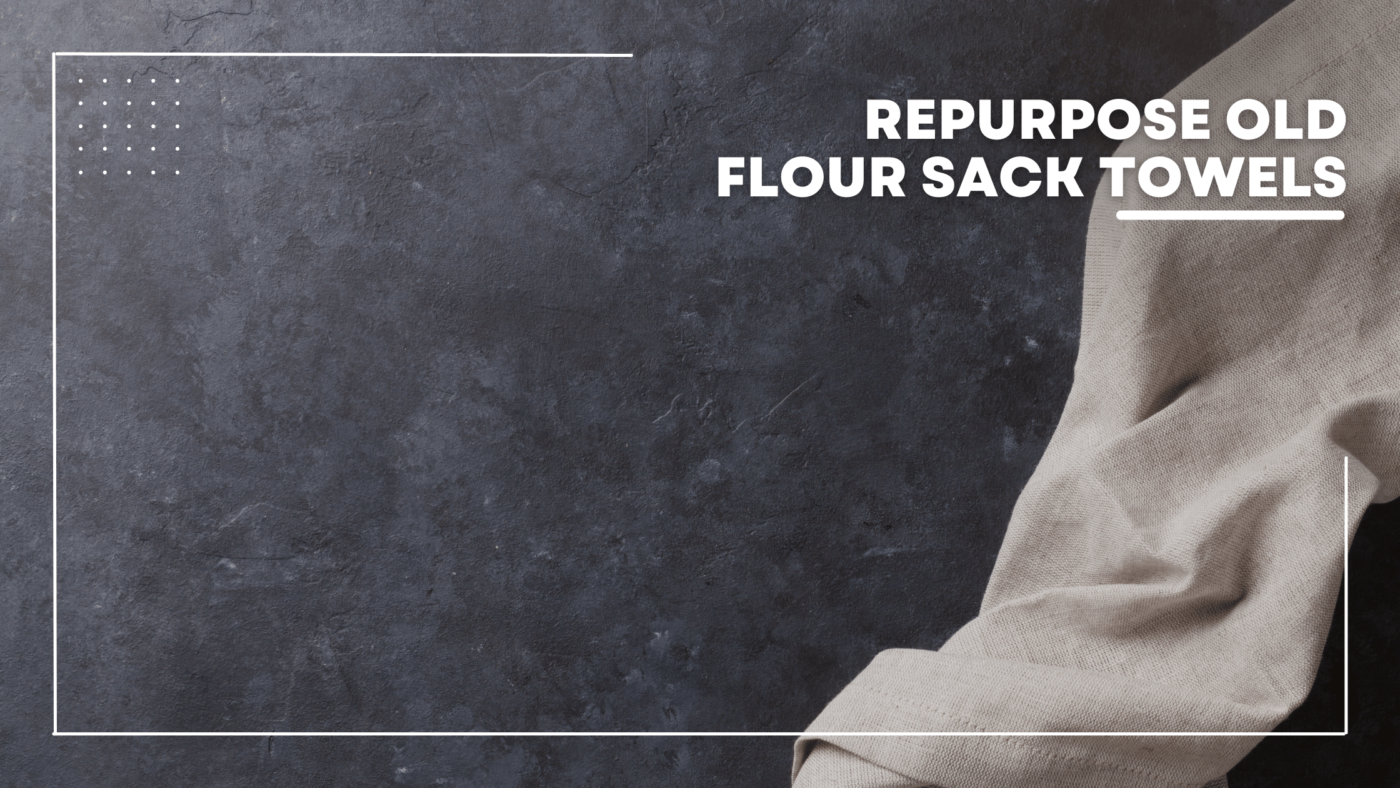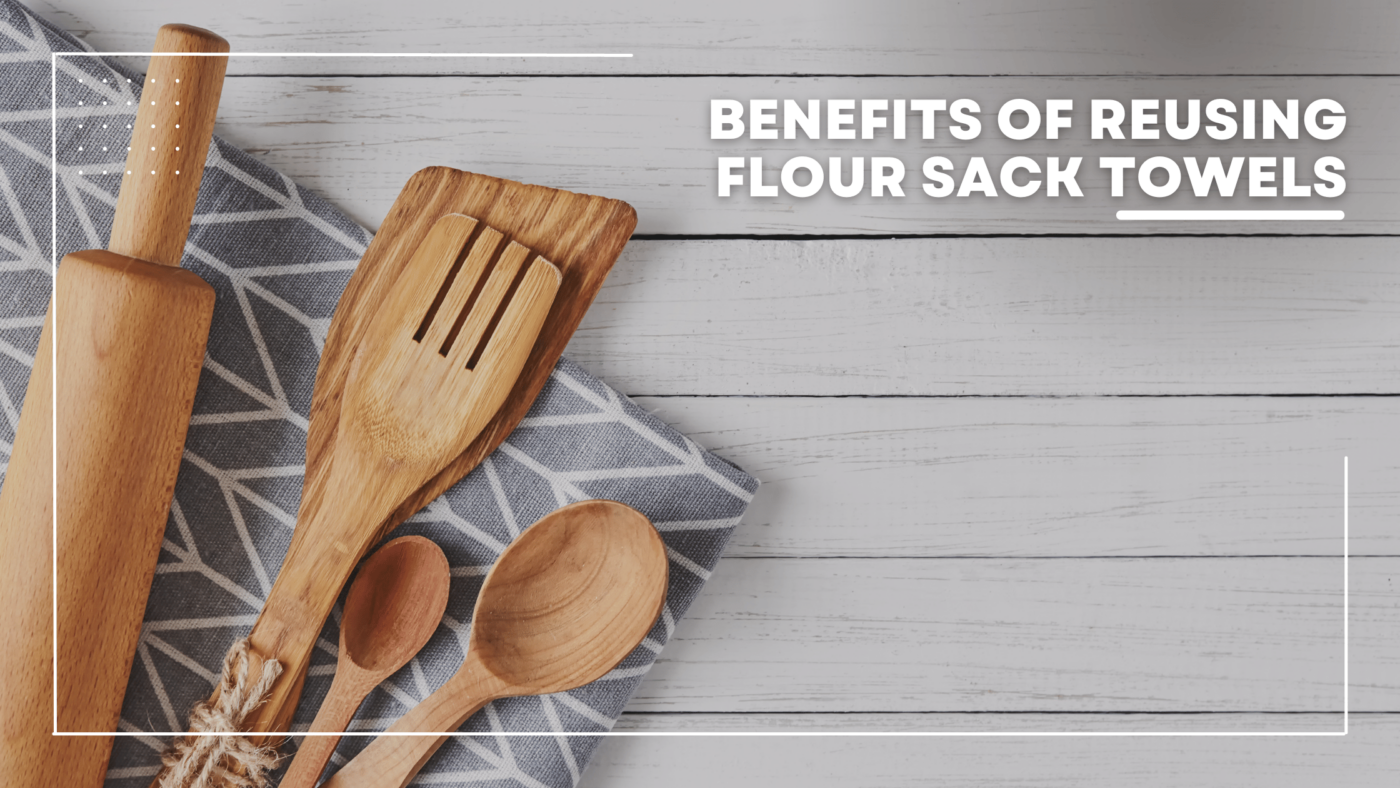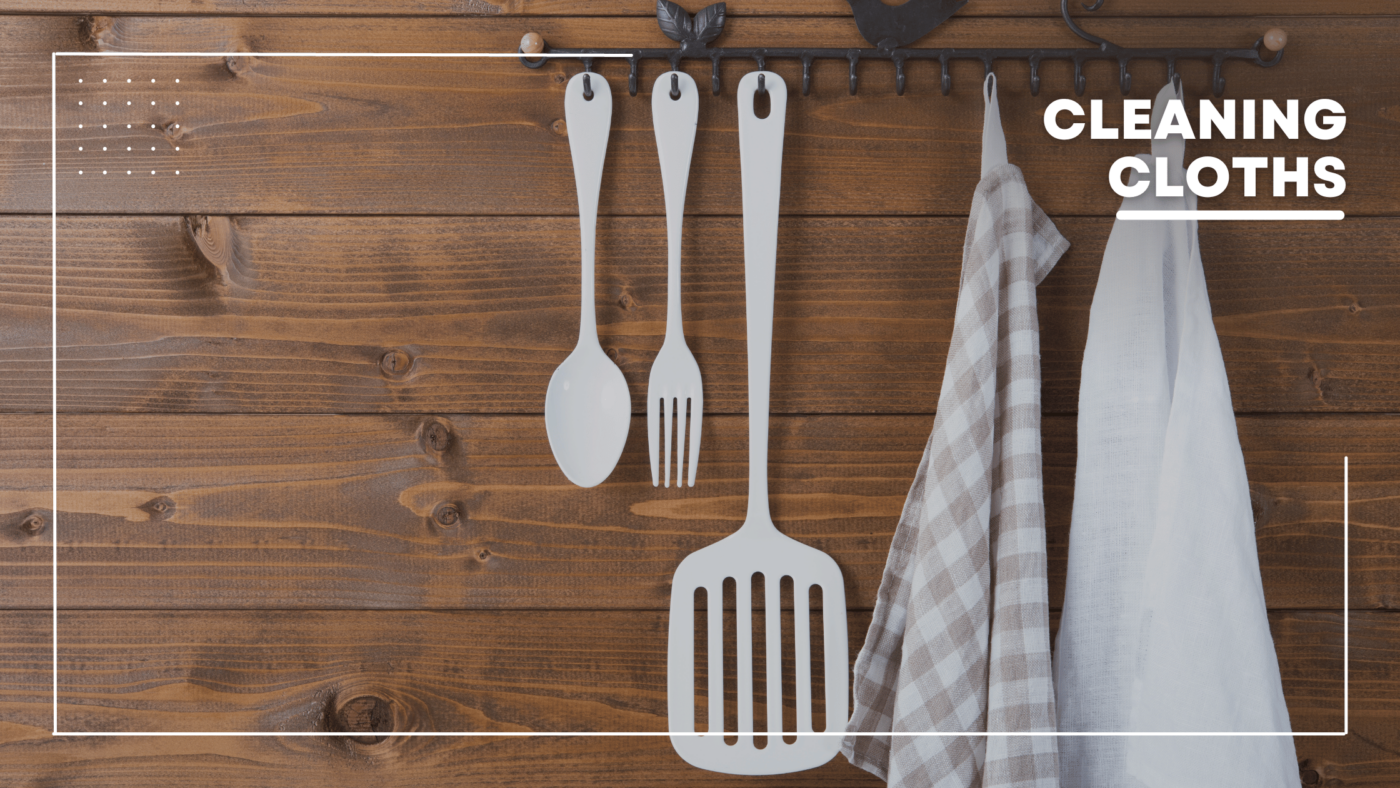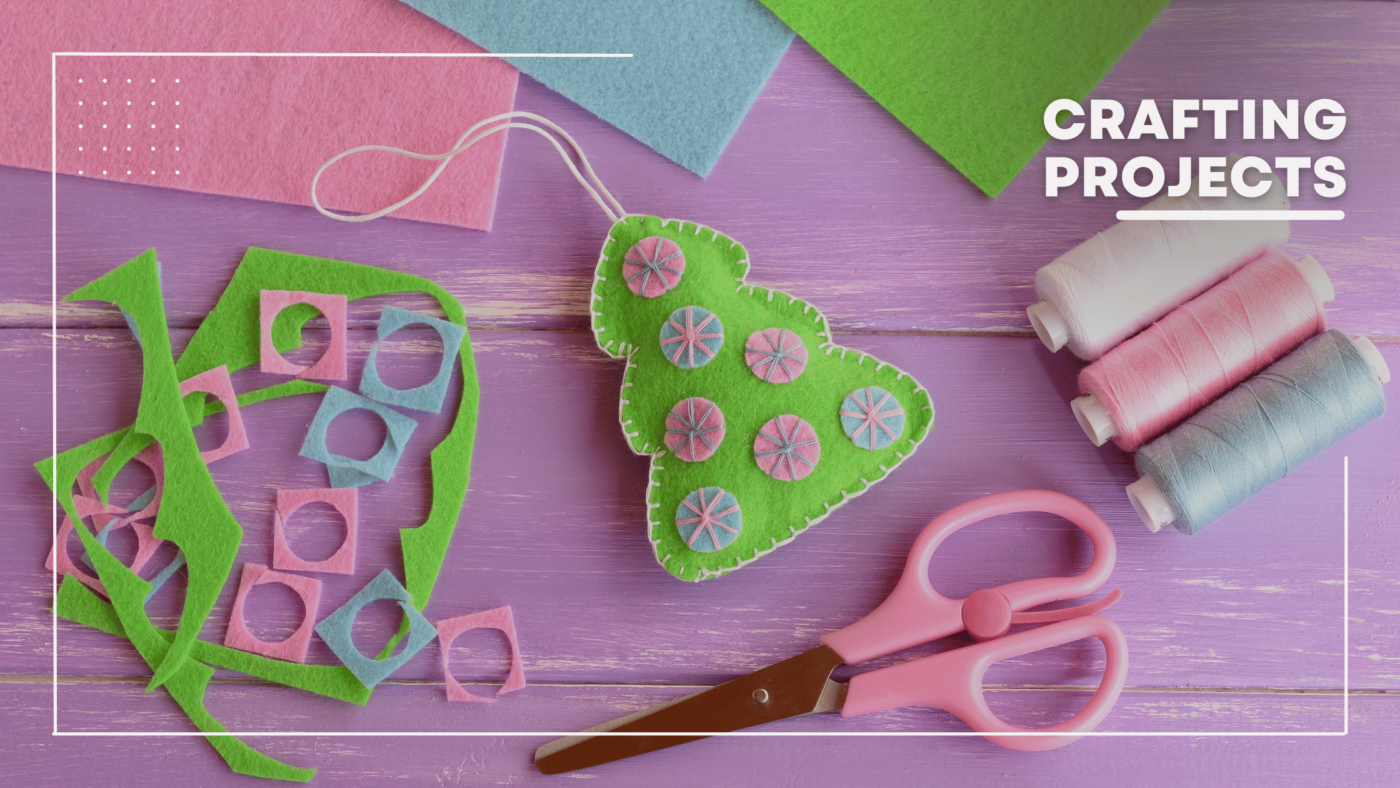Blog
Clever Ways To Repurpose Old Flour Sack Towels
Flour sack towels are a versatile and economical way to tackle household tasks. They have been around for centuries, but recently have become more popular due to their frugal value and environmental friendliness. This article will explore five clever ways to repurpose old flour sack towels in order to make the most of them.
The versatility of these multi-purpose cloths provides many opportunities for creative reuse. Flour sack towels can be used as an alternative to paper products or recycled materials such as fabric scraps in order to create new items with minimal effort. Additionally, they are sustainable and biodegradable which makes them ideal for crafting projects that benefit both people and the environment.
Finally, there is no limit to what one can do with flour sack towels; from soft furnishings like pillows and blankets, to art projects and even fashion accessories. With some imagination, it is easy to come up with ideas on how best use this resourceful material. The following list of five clever ways to repurpose old flour sack towels demonstrates just how much potential these humble pieces of cloth possess.
Definition
Flour sack towels are a type of cloth material that is typically made from cotton and often used in the kitchen for baking or to cover bread dough. Flour sack towels have been utilized for centuries, primarily due to their lightweight yet durable properties as well as their absorbent qualities. Though traditionally used for food preparation, these materials can also be repurposed for other creative uses around the home.
In recent years, flour sack towels have become increasingly popular among DIYers who appreciate their versatility and cost-effectiveness. As such, repurposing old flour sack towels has become an innovative way to extend the life of household items while conserving resources at the same time. From crafting projects to upcycling furniture pieces, there are many clever ways to reuse these fabrics in both practical and decorative manners.
By reimagining old flour sack towels in new ways, not only can one save money on typical consumable products but they may also be able to add unique value to any space within the home. With some creativity and imagination, individuals may find plenty of options when it comes to finding alternative uses for their existing fabrics.
Benefits Of Reusing Flour Sack Towels
The concept of reusing old materials is becoming increasingly popular, as individuals recognize the environmental and economic benefits that come from repurposing pre-existing items. Flour sack towels exemplify this trend, with their versatile nature allowing them to be used for a variety of purposes in numerous applications. The sustainability associated with upcycling such fabrics can help reduce waste while still achieving desirable aesthetic results.
In addition to being beneficial for the environment, these cloths offer further advantages thanks to their absorbency and strength. Since flour sack towels are lightweight yet durable, they can provide useful protection against spills or other messes without detracting from the look of any space within the home. Furthermore, due to their breathable properties, flour sack towels also make great cleaning rags and dusters which can be washed and reused over time.
Overall, it is clear that there is much potential when it comes to finding alternative uses for flour sack towels rather than simply discarding them after one use. By understanding the various benefits that these fabrics have to offer, individuals may find value in preserving them beyond what was originally intended by using creative methods for reuse.
Creative Ideas
With the various advantages that flour sack towels provide, individuals may be interested in exploring creative ways to repurpose them. From art projects to home décor and more, there are a variety of methods for reusing these fabrics as part of an effort towards sustainability.
One way to make use of old flour sack towels is through craft-making. By cutting the material into shapes or patterns, it can be used in conjunction with other items such as buttons or beads to create unique works of art. For example, pillows, wall hangings, and quilts can all be constructed using this type of cloth as fabric pieces for a colorful result. Furthermore, by adding embellishments like stitching or appliqués, further customization options become available when crafting with flour sack towels.
Another way that these materials can be reused is within interior design schemes. Using pre-existing fabrics instead of purchasing new upholstery is not only cost effective but also provides interesting visual elements due to the unique patters and textures inherent in each piece. In addition, their absorbent properties make them ideal for use on furniture covers where spills might occur frequently; providing both decoration and protection simultaneously.
By taking advantage of these possibilities, individuals can find innovative uses for flour sack towels that go beyond their original purpose while still achieving desirable outcomes. With so many potential applications available from upcycling these fabrics, they serve as an excellent resource when seeking sustainable solutions for housekeeping tasks or decorating ideas alike.
Cleaning Cloths
In addition to craft-making and interior design, flour sack towels can also be used as a versatile cleaning cloth. According to the U.S. Environmental Protection Agency (EPA), Americans generate an average of 4.40 pounds of waste per person daily; much of which is due to disposable paper products like paper towels that are designed for single-use applications. By opting for reusable cloths instead, individuals can make a positive impact on their carbon footprint while still receiving reliable cleaning performance from these fabrics.
Here are three ways in which old flour sack towels can serve as effective alternatives:
- Due to their long fibers, they possess excellent absorbency capabilities when wetted down with liquid solutions; making them ideal tools for wiping up spills or quickly removing dust particles without leaving streaks behind.
- As opposed to disposable options, they do not contain any chemical additives or fragrances; allowing them to act as safe surfaces upon which food items may be prepared without fear of contamination occurring.
- Additionally, since they dry relatively fast after use, multiple tasks can often be completed within short periods of time before needing to replace the towel with a new one again.
Given these qualities, it’s clear why repurposing old flour sack towels into cleaning cloths offers numerous advantages over traditional methods such as paper towels or sponges. This practice not only allows users access to more efficient and sustainable solutions but could potentially save money too by reducing the number of times replacements must be purchased in order to maintain hygiene standards around the home or workplace environment alike.
With this information in mind, it’s easy to see how incorporating unused flour sacks into everyday routines can help reduce both environmental and financial costs simultaneously — paving the way towards greener living practices overall. Moving forward then, let us now consider other potential uses for these materials beyond just being utilized as cleaning supplies…
Tea Towel Alternatives
In addition to being utilized as cleaning supplies, flour sack towels can also be used in place of tea towels. Tea towels are traditionally made from terry cloth and absorb liquid quickly when wet; however they’re not always the most eco-friendly choice due to their high production costs and short lifespan. By opting for a repurposed flour sack towel instead, individuals can benefit from similar results but with fewer environmental repercussions overall.
Here are three benefits of utilizing these fabrics:
- Since they’re highly durable and retain their shape after laundering, old flour sacks offer greater longevity than traditional materials; meaning less money needs to be spent on replacements over time.
- Not only do these fabrics dry quicker compared to other options, but their light weight makes them ideal for storing away easily when not in use — saving precious countertop space in the process.
- In comparison to paper products such as napkins or disposable wipes that generate waste upon disposal, reusable alternatives like those created through upcycling help minimize landfill contributions significantly.
It’s evident then how reusing old flour sacks offers more sustainable solutions as opposed to buying new items every so often. Moreover, this practice may even provide additional cost savings too by reducing the number of purchases necessary throughout the year while still providing reliable performance at the same time — making it an attractive option all around. With this knowledge in mind now let us consider yet another potential application for these textiles…
Wrapping Paper
Just as a sailor utilizes their ship’s sails to navigate through treacherous waters, so too can the savvy individual set sail with old flour sacks in order to reach new realms of repurposing. From tea towels to wrapping paper and beyond, these durable fabrics offer endless possibilities when it comes to crafting projects that are both eco-friendly and cost effective.
When used for gift-wrapping purposes, flour sack towels provide an array of benefits including:
• A variety colors and patterns — allowing users to customize presents according to whatever occasion or theme they may be celebrating.
• Ability to re-use them multiple times due to their strong construction; thus reducing waste associated with buying single-use paper rolls annually.
• Versatility when it comes to folding techniques—from traditional geometric shapes like triangles and rectangles all the way up complex origami designs!
• Affordability given that most households will have several lying around already waiting for a second life.
By taking advantage of these advantages, individuals can turn a humble kitchen supply into something quite extraordinary indeed. With some creativity added into the mix, there are almost no limits on what one might create from fabric alone; making this particular task yet another excellent option for those who want to find clever ways of repurposing old items easily at home.
Crafting Projects
With a bit of imagination and elbow grease, flour sack towels can be transformed into many different crafting projects. From wall art to pillow covers, these fabrics offer an array of possibilities that can help breathe new life into an otherwise mundane item. Here are some popular ideas on how to repurpose old flour sacks:
• Wall Hangings – Transform the towel into something decorative by embroidering or cross-stitching it with intricate designs and patterns. This is also a great way for those who enjoy creative expression as well as upcycling!
• Pillow Covers – Replace your existing pillows’ cases with pieces cut from flour sacks for a more rustic look in your bedroom décor.
• Aprons & Tablecloths– Bring charm to your kitchen when making use of cooking aprons or tablecloths made out of the fabric; both will give you added protection against spills while adding vintage vibes to any gathering or dinner party.
The possibilities truly are endless when it comes to reimagining these materials — so don’t let them go neglected! With just a few supplies such as needle and thread, scissors, glue and paint, anyone can easily make something special out of their used floursacks which not only looks good but also helps reduce waste at home.
Gardening Uses
It is widely believed that flour sacks can be repurposed for use in the garden. With a bit of knowledge, these materials can provide an excellent and cost-effective solution to many gardening needs. From providing support for climbing plants to keeping insects away from the flowers, these fabrics offer great versatility when it comes to sprucing up your green space.
For example, they can make excellent trellises by stringing them between posts or stakes with some twine. Once attached, climbers such as vines and beans will have something to grab onto while growing upwards. Additionally, hanging them around doors or windows may help keep pesky bugs at bay due to their tight weave which prevents most insect species from passing through easily.
Lastly, if you’re looking for a more decorative touch, consider cutting up old towels into strips and then weaving pieces together into a basket shape — this process not only creates attractive storage solutions but also makes use of otherwise discarded materials!
Pet Accessories
In addition to the many gardening uses of flour sacks, they can also be repurposed into a variety of pet-related accessories. From dog beds and blankets to cat toys and scratching posts, these materials are incredibly versatile when it comes to providing comfort for our furry friends.
For starters, old towels can make great dog beds or cushions as they provide plenty of softness without taking up too much space in your home. To create one of these cozy spots for your pup, simply stuff an old towel with some stuffing material before sewing together the edges — you’ll have a homemade bed in no time! Furthermore, if you have cats that like to scratch furniture, consider making them their own post by wrapping cloth around a wooden dowel or PVC pipe. Not only will this save your couch from future damage but it will also give your kitty something fun to play with!
Finally, why not get creative and transform those discarded fabrics into unique cat toys? Simply cut out shapes such as stars or hearts and then fill them with small items like bells or feathers before stitching closed. Your feline friend is sure to love playing with their new toy while giving you peace of mind knowing that you’ve helped keep valuable resources out of landfills.
Storage Solutions
From pet accessories to storage solutions, the possibilities for repurposing old flour sack towels are simply endless. With a little bit of ingenuity and creativity, these simple materials can be transformed into something new that will bring beauty and functionality to your home. Indeed, it’s almost like magic!
For those looking to save space in their homes while still keeping items organized and accessible, consider creating convenient hanging organizers out of these fabric scraps. To do so, just cut two equal-sized pieces of cloth before stitching them together along three sides — leaving one side open. Then stuff with whatever you need stored away such as notebooks or craft supplies — voila, instant wall hanging storage pockets! This is an incredibly easy DIY project that will help keep all your essentials at arm’s reach while freeing up valuable floor space.
Of course, if you prefer more traditional storage solutions then how about turning some leftover material into pretty baskets? All you have to do is take two equally sized squares of fabric and sew around the edges before folding inward and sewing shut again -– no additional tools needed here! These handy containers can store anything from books to toys yet look stylish enough to display on shelves or tables without taking away from your décor.
Frequently Asked Questions
Is It Safe To Use Flour Sack Towels For Food Preparation?
The use of flour sack towels for food preparation is a common practice, but one that warrants further discussion. Before determining if the practice is safe, it is important to understand what these towels are and how they may be used in the kitchen. Flour sack towels are typically lightweight cotton cloths with open-weave designs that make them highly absorbent. They can be used for drying dishes or wiping down countertops because their texture helps prevent bacteria from spreading around the kitchen.
When using flour sack towels for food preparation, there are several factors to consider. First, they should always be clean before being placed on any surface where food will come into contact with them. Additionally, it is important to ensure that no harmful chemicals or dyes have been applied to the towel which could transfer onto food items when preparing meals. Finally, it is also recommended to regularly replace these towels as often as possible so that bacteria does not build up over time.
Overall, while flour sack towels may offer some benefits when used correctly during meal prep, caution must still be taken to avoid potential contamination risks associated with improper handling of these materials. With proper care and regular replacement of worn out pieces, however, the use of such tools can certainly add convenience and efficiency when working in the kitchen.
How Often Should I Wash My Flour Sack Towels?
Using flour sack towels for food preparation is a common practice and can be safe when done correctly. However, one of the most important aspects to consider with regards to using these items for culinary purposes is how often they should be washed. This article discusses this key factor in greater detail.
When it comes to washing flour sack towels, frequency largely depends on what kind of activities are taking place with them. For example, if the towel has been used several times for different tasks such as wiping down kitchen counters or drying dishes without any contact with raw foods like meat or poultry, then it may only need to be laundered once every two weeks or so. On the other hand, if the towel has been used directly on surfaces where bacteria-containing foodstuffs have come into contact with it, then laundering needs to take place much more frequently – ideally after each use.
In addition to frequency considerations, proper care must also be taken when cleaning flour sack towels in order to ensure maximum hygiene and safety standards are maintained. The best way to do this is by machine washing at warm temperatures (around 40°C) and tumble drying afterwards on a low heat setting; this will help kill off any lingering bacteria present on the material quickly and effectively before reuse.
TIP: Whenever possible, opt for dedicated dish cloths rather than repurposing old flour sack towels for food preparation duties due to their tendency to collect germs over time even when properly cleaned regularly.
How Do I Remove Stains From Flour Sack Towels?
Have you ever wondered how to remove stubborn stains from your old flour sack towels? Recent studies have shown that over 86% of Americans struggle with this problem. Fortunately, there are several ways to effectively and safely get rid of pesky spots on these beloved kitchen staples:
• Pre-treat the stained area using a mixture of dish soap and hydrogen peroxide
• Soak in warm water for at least an hour before laundering
• Rub the stain with baking soda or a gentle abrasive cleaner such as Bon Ami
If pre-treatment fails, it may be necessary to use a stronger cleaning solution such as bleach or vinegar. However, always test any solvent on a small inconspicuous patch of the fabric first to make sure it won’t damage the material. Additionally, never mix two different types of solvents together as they can form dangerous fumes. When finished treating the stain, machine wash normally according to manufacturer instructions – hot water is usually best for most stains.
When done properly, removing tough stains from your flour sack towels doesn’t have to be difficult! With a few simple steps and some elbow grease, you can keep them looking clean and new for years to come!
How Do I Store My Flour Sack Towels?
Storage of flour sack towels is an important consideration, given their use. Flour sack towels are often used in the kitchen and utility room for many purposes such as cleaning surfaces, wiping down dishes, straining food items, or holding hot pots and pans. With regular use, these towels need to be stored properly when not in use so that they stay clean and remain usable.
A common method of storing flour sack towels is by folding them neatly and placing them in a drawer or cabinet near where they will be most needed. This helps keep the towels from becoming wrinkled, stained or dirty while still making them readily accessible when needed. Another option is to hang them on hooks near the sink or other area where they can easily be accessed for quick drying after washing. For those who prefer to store laundry items together separately from kitchen linens, hanging towel bars provide another storage solution for flour sack towels.
Regardless of how you choose to store your flour sack towels it’s important to make sure that there is adequate ventilation available so that mildew does not form and cause additional damage over time. Furthermore, if possible try to avoid areas with direct sunlight which may fade colors or patterns on the fabric material over time. Taking these simple steps into consideration should help ensure that your flour sack towels last longer and stand up better against wear and tear due to daily use.
Can I Use Flour Sack Towels To Make Clothing?
Flour sack towels are an incredibly versatile item, with a plethora of potential applications that have yet to be explored. As such, it would not be far-fetched to suggest that flour sack towels can also be used to make clothing. Indeed, the question ‘can I use flour sack towels to make clothing?’ is worth considering. To answer this question, one must first consider the properties of these materials and how they lend themselves towards garment construction.
The material itself is quite lightweight but still relatively sturdy; its natural absorbency makes it ideal for making items like aprons or dishcloths which might require frequent laundering. Furthermore, due to their naturally soft texture, flour sacks could easily be fashioned into garments for babies and toddlers who may require more delicate fabrics against the skin than adults do. Additionally, as many styles already come pre-printed with various designs on them, there is much scope for creativity when crafting clothes from this material.
To unlock the full potential of repurposing old flour sacks into fashion pieces requires some sewing knowledge as well as access to machines and other tools required for garment construction. However, even those without any prior experience in textile work will find plenty of resources available online where step by step instructions on creating your own unique clothing items out of fabric scraps can be found. TIP: It can help if you use tailor’s chalk or dressmaker’s carbon paper when transferring patterns onto the fabric before cutting!
Conclusion
The use of flour sack towels is a great way to repurpose old materials and reduce waste. It offers many possibilities in terms of home décor, clothing, cleaning and food preparation. The white fabric symbolizes purity and cleanliness that can be used for multiple purposes around the house. With a few simple tips, it’s easy to keep these multipurpose towels looking like new for years to come.
To protect against bacteria growth, it is essential to wash your flour sack towels regularly between uses for food-related activities. If you find yourself with stubborn stains on the material, pre-treating the surface before laundering may help remove them more effectively than regular washing alone. Store your towels away from direct sunlight or moisture when not in use to maintain their quality over time.
Perhaps one of the most interesting ways to put flour sack towels into action is by turning them into stylish garments such as aprons, scarves and bags. These fabrics are lightweight yet strong enough to provide coverage while also adding texture and colour to any outfit; an excellent example of how creativity can produce something unique out of otherwise ordinary materials. By using these five clever ideas along with some imagination, there are countless opportunities available within this highly versatile material!






